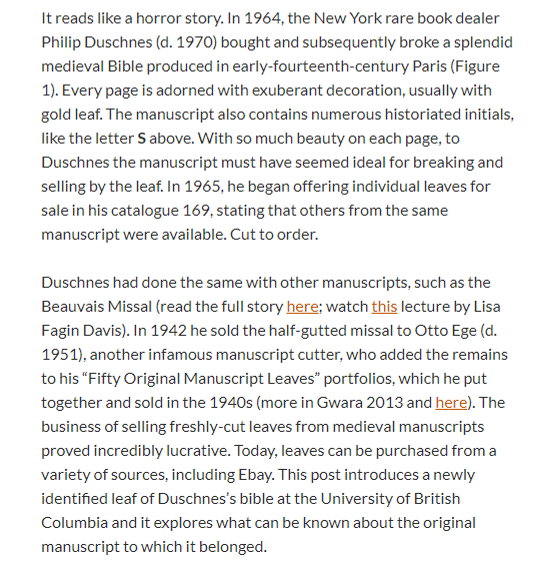The anatomy of a blog post
Blogging is a much freer activity than academic writing. You are both author and publisher, so anything goes. Still, it is wise to structure your texts. You have a set of traditional building blocks at your disposal. These elements make your readers start reading and get the point. They also help you when setting up the text and express your ideas.
Here I describe the most important textual building blocks of a blog. I illustrate them with a post from Medievalbooks.nl, the blog of book historian Erik Kwakkel (take a look at his Twitter timeline if you want to learn how to get 30K followers). You might as well choose a post of your favourite blog to see how the author applies structural elements.
Title
The title often is part of the first impression people get of your post. Its primary function is to attract the attention, make people stop scrolling through their timeline and click. And, secondly, it also should give your readers an idea of what they might expect when they read the blog.

Intro
The intro is a piece of text that has the sole purpose of making people curious. Unlike the lead, your readers can skip the intro without missing information. The intro has a different font than the body text. On a news website, you often find tiles composed of an image, title and intro. When clicking on the article, you will see the intro again.
Lead
The lead is the first paragraph (in longer texts, it can be two or even three paragraphs) of the text. The first thing it does is make people read. It starts with (a) short sentence (s). This part should be simple (now jargon allowed here) and relevant (link to the everyday life of your reader). It sets the scene. The lead then presents the main point or question the text answers.

Paragraphs
Paragraphs present parts of the main point of the text. They each have an own clear beginning-middle-end structure. The three elements of a paragraph are:
- Topic sentence. This is mostly the first sentence of the paragraph. It presents the main idea, or the point, of the paragraph and is clearly related to the main point of the text.
- Supporting details. This support proves the point of the paragraph. An alternation of different types of support makes your text more easily to read. Different types of support are:
- Observations and experiences
- Anecdotes
- Examples
- Facts
- References
- Quotations
- Statistics
- Explanations
- Reasons
- Closing sentence. This last sentence of the paragraph closes the paragraph and links back to the topic sentence.

Subheadings
Like the title of your post, subheadings have a twofold purpose: to inform and attract. They show the structure of the text in a glimpse and they motivate your readers to keep reading. They add a bit of air to the otherwise discouraging amount of words. Try to create subheadings that are related to the paragraphs that follow them, but that are also attractive. They do not have to cover the whole contents, but can contain a juicy detail.
In my texts (both blogging and journalistic writing) I prefer a clear cadence of paragraphs with comparable length and a subheading for each two (for shorter texts) or three (for longer texts) paragraphs. When looking for the right words I usually look at the end of the paragraphs a subheading covers. I try to first make my readers curious and then postpone the satisfaction a bit.

Closing
The last paragraph closes the loop of the text. It links back to the main point introduced in the lead and adds a conclusion. If you asked a question, go back to it and answer it here. Do not include new information. The introduction zooms in from the general/everyday life of your reader to the specific topic of your post. The concluding paragraph zooms out from the specific to the general/everyday life of your reader. Give the loyal reader that made it to the end a present. It can be for instance an advice for how to implement the lessons of the text to the everyday life, a joke, or a cliffhanger (if you are continuing the story in the next post).

References
You can add a list of references at the end of the post. It serves a similar purpose as in a peer reviewd paper. Readers from your field might want to read your sources. However, when writing for the broader public, this can look a bit funny (you will never see references in a news article). An alternative can be to add a link in the text where you reference the work of others (or yourself).

